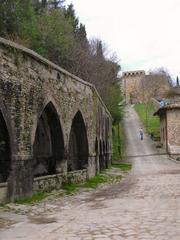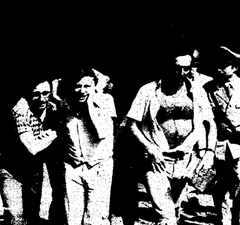
Piazza del Duomo, San Gimignano: Visiting Hours, Tickets, and Historical Sites Guide
Date: 04/07/2025
Introduction: History and Significance
Nestled in the heart of Tuscany, Piazza del Duomo in San Gimignano is a striking testament to medieval Italy’s heritage, architectural beauty, and vibrant culture. Nicknamed the “Medieval Manhattan” for its famous skyline of towers, this square has been the spiritual and civic center of San Gimignano since the 10th century. Once a bustling stop along the Via Francigena, the town flourished as a center of commerce, art, and pilgrimage, leaving behind an urban landscape that vividly narrates tales of power, faith, and artistry (San Gimignano History, Love from Tuscany, Italy Gonia, Wikipedia).
Piazza del Duomo’s blend of Romanesque and Gothic architecture, highlighted by the Collegiata di Santa Maria Assunta and the imposing Torre Grossa, makes it a living museum. Today, the square remains a lively focal point for festivals, historical reenactments, and community events, inviting visitors to step back in time and experience the enduring spirit of medieval Tuscany.
Table of Contents
- Introduction
- Origins and Early Development
- Medieval Flourishing and the Birth of Piazza del Duomo
- Architectural Evolution
- Cultural Significance
- Historical Events and Preservation
- Visiting Information
- Frequently Asked Questions (FAQ)
- Conclusion
Origins and Early Development
San Gimignano’s roots can be traced to prehistoric and Etruscan settlements. The town’s legendary founders, Muzio and Silvio, are said to have established the first castles in the region after fleeing Rome in the 1st century BC. The earliest recorded mention of San Gimignano, however, dates to 929 AD, referencing the “Mount of the Tower next to San Gimignano” (San Gimignano History). By the 10th century, the village had grown into a fortified settlement along the important Via Francigena, under the influence of the Bishop of Volterra.
Medieval Flourishing and the Birth of Piazza del Duomo
San Gimignano reached its zenith between the 11th and 14th centuries, flourishing as a vital waypoint for pilgrims and traders. Wealthy families built more than 70 towers—status symbols of power and rivalry. Piazza del Duomo emerged as the town’s religious and civic heart, with its current form taking shape in the 13th century. The realignment of the Duomo to face the Palazzo Vecchio del Podestà symbolized the assertion of communal autonomy (Wikipedia - Piazza del Duomo, Live the World).
Architectural Evolution
The Collegiata (Duomo di San Gimignano)
This Romanesque church, dating from the 12th century, is a masterpiece of Tuscan religious architecture. Its sober façade gives way to a richly frescoed interior, featuring:
- Old Testament Cycle by Bartolo di Fredi
- New Testament Cycle by Barna da Siena
- Last Judgment by Taddeo di Bartolo
- Chapel of Saint Fina by Domenico Ghirlandaio
The church’s frescoes are among Italy’s best preserved and most significant, earning UNESCO recognition (Wikipedia, Love from Tuscany).
Civic and Noble Buildings
Across from the Duomo stands the Palazzo Vecchio del Podestà, the former seat of justice, and the Palazzo Comunale (Town Hall), home to the Museo Civico and the Pinacoteca. Torre Grossa, the tallest tower (54 meters), offers panoramic views of the town and countryside. The square is further framed by noble family towers, including the Torri Gemelle dei Salvucci (Salt in Our Hair).
Cultural Significance
Throughout history, Piazza del Duomo has been the center of San Gimignano’s religious, political, and social life. Its strategic location made it a hub for travelers and merchants. Artistic patronage brought renowned masters such as Ghirlandaio and Benozzo Gozzoli, whose works enriched the town’s monuments. Today, the square remains a vibrant venue for festivals, concerts, and traditional events like the Ferie delle Messi (San Gimignano History).
Historical Events and Preservation
The Black Death of 1348 and subsequent decline preserved much of San Gimignano’s medieval character. Few new buildings were added after the 15th century, and many towers were reduced in height. This historic stasis, ironically, protected the town’s unique skyline. The entire historic center, including Piazza del Duomo, is now a UNESCO World Heritage Site due to its outstanding preservation (Salt in Our Hair).
Visiting Information
Hours and Tickets
- Piazza del Duomo: Open public space, accessible year-round.
- Duomo di San Gimignano: Typically open 10:00 AM–6:00 PM (seasonal variation).
- Torre Grossa and Museo Civico: Open 10:00 AM–7:00 PM in summer, shorter hours in winter.
- Tickets: Combined tickets (€9–€12) grant access to the Duomo, Torre Grossa, and Museo Civico. Purchase online or onsite—advance booking is recommended in peak season.
Guided Tours and Accessibility
Guided tours in multiple languages provide insight into the piazza’s history and art. Audio guides are available. The square itself is level and accessible, but some monuments (like Torre Grossa) require climbing stairs. Visitors with mobility concerns should consult the tourist office about accessible routes and facilities.
Travel Tips and Nearby Attractions
- Best Times: Early mornings and late afternoons for softer light and fewer crowds.
- Nearby Highlights: Palazzo Comunale, Museo Civico, Rocca of Montestaffoli, artisan shops, and vineyards.
- Dining: Enjoy local specialties and Vernaccia wine in the piazza’s cafés or nearby restaurants.
- Events: Check for festivals, markets, and concerts that may enhance your visit.
Frequently Asked Questions (FAQ)
Q: What are the main visiting hours?
A: The piazza is always open. The Duomo and museums typically operate from 10:00–17:30 or 18:00, with extended hours in summer.
Q: How much do tickets cost?
A: Combined tickets for the Duomo, Torre Grossa, and Museo Civico are €9–€12, with discounts for children, students, and seniors.
Q: Are guided tours available?
A: Yes, guided and audio tours are offered in several languages.
Q: Is the area wheelchair accessible?
A: The piazza is generally accessible, but some monuments have steps and uneven surfaces.
Q: How do I get there?
A: By public transport, take a train to Poggibonsi and a bus to San Gimignano. By car, park outside the walls and walk into the center (frompoletoequator.wordpress.com).
Practical Tips
- Footwear: Wear comfortable shoes for cobblestones and hills.
- Weather: Prepare for hot summers; bring water and sun protection.
- Cash: Carry some euros for small shops and the market.
- Photography: The best light is in the early morning or late afternoon.
- Luggage: Free bag check is available at the Tourist Information Centre.
- Dress Code: Modest attire is required for church entry.
Visuals and Media
Related Articles
- Discover the Medieval Towers of San Gimignano: A Complete Guide
- Top Historical Sites to Visit in Tuscany
- How to Plan Your Tuscany Itinerary: Tips and Must-See Destinations
Conclusion
Piazza del Duomo in San Gimignano is a living monument to medieval Tuscany’s grandeur, artistry, and communal spirit. Its architectural masterpieces, art-filled interiors, and lively events promise an unforgettable experience for every visitor. Plan ahead for tickets and tours, arrive early or late to skip the crowds, and savor both the history and present-day vibrancy that define this UNESCO World Heritage site.
For more travel guides and up-to-date information, download the Audiala app and follow us on social media for insider tips and event updates.
References and Useful Links
- San Gimignano History
- Love from Tuscany
- Italy Gonia
- Wikipedia - Collegiata di Santa Maria Assunta, San Gimignano
- Salt in Our Hair
- Live the World
- frompoletoequator.wordpress.com



